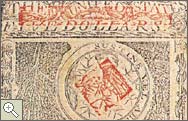
Prices soared as more and more of the paper money went into circulation. Toward the end of the war, a pair of shoes in Virginia cost five thousand dollars in state bills; a suit of clothes cost as much as a million. An expression of the time, "A wagonload of Continentals will hardly purchase a wagonload of provisions,"; has been ascribed to George Washington. Part of the reason that Washington's men were so poorly provisioned at Valley Forge was that merchants in the area only did business with British troops, who could pay in coin.
In 1780, the American government began to lay the groundwork for a new economic system. With money borrowed from France and Spain, Congress was able to redeem Continentals at the rate of forty dollars in bills to one dollar in coin. The bills were then destroyed.
The wartime money turned out to be worthless to the new nation, but it was instrumental in the achievement of nationhood. And, like so much else about the American Revolution, it was something new to the world.
"If the history of commercial banking belongs to the Italians and of central banking to the British," wrote economist John Kenneth Galbraith, "that of paper money issued by a government belongs indubitably to the Americans."
|
 |
 |
 |
 |

New Hampshire, April 29, 1780, back.
|
 |
 |

This illustration first appeared on a Continental in 1775. Benjamin Franklin wrote an interpretation of it in the Pennsylvania Gazette:"The bush I suppose to mean America, the bleeding hand Britain. Would to God that bleeding were stopt, the wounds of that hand healded, and its future operations directed by wisdom and equity; so shall the hawthorn flourish, and form an hedge around it, annoying with her thorns only its invading enemies."
|
 |
 |
 |
|

